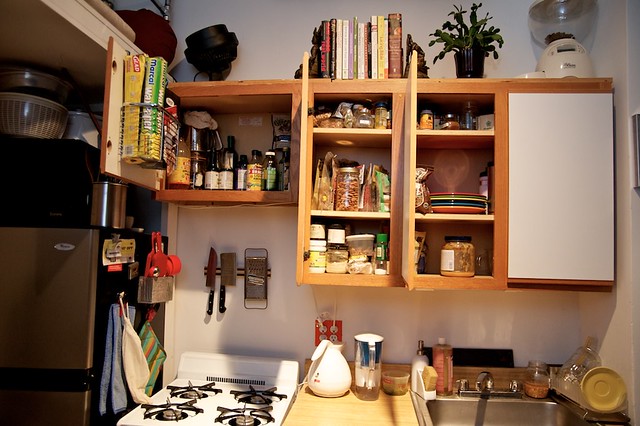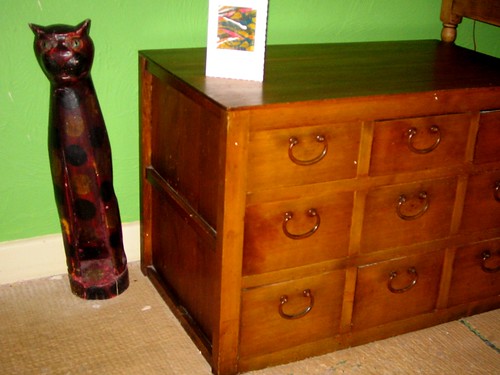A friend asked me about the difference between cupboards, cabinets and closets, so I thought I’d look into it and write a post about it.
A cupboard is
- A storage closet either separate from, or built into, a wall.
- Things displayed on a sideboard; dishware, particularly valuable plate(16th-19th century).
- A board or table used to openly hold and display silver plate and other dishware; a sideboard; a buffet (14th-18th century).
Note that kitchen cupboards are also known as kitchen cabinets. What do you call them?
It comes from Middle English cuppeborde (sideboard), from cuppe (cup) and bord (board, slab, table) [source].
If something is small, fusty or poorly lit, you could call it “cupboardy” [source].
A cabinet is
- A storage closet either separate from, or built into, a wall.
- A cupboard.
- A group of advisors to a government or business entity.
- A group of government ministers responsible for creating government policy and for overseeing government departments.
- A small chamber or private room (archaic) [source].
Originally it meant a secret storehouse, treasure chamber or case for valuables. It comes from Middle French cabinet (small room), a diminutive of the Old French cabane (cabin) [source], from Old Provençal cabana, from Late Latin capanna/cabanna (hut), which is of uncertain origin [source].
A closet is
- A small room within a house used to store clothing, food, or other household supplies.
- A secret or hiding place.
- A small room or side-room (mainly in Scotland and Ireland)
- A small room or side-room intended for storing clothes or bedclothes. (in the USA and Philippines)
Obsolete and archaic meanings of closet include:
- Any private space, (particularly) bowers in the open air.
- Any private or inner room, (particularly):
– A private room used by women to groom and dress themselves.
– A private room used for prayer or other devotions
– A place of (usually, fanciful) contemplation and theorizing.
– The private residence or private council chamber of a monarch. - A pew or side-chapel reserved for a monarch or other feudal lord.
An American-style closet (as in the photo above) might be called a built-in wardrobe in the UK. What would you call it?
It comes from Old French closet (a small enclosed area, such as a field or paddock), from clos (enclosed outdoor area, such as a field or a paddock), from Latin clausum (enclosed space, enclosure) clausus (shut, closed), from claudō (I shut, close, lock), from Proto-Italic *klaudō (I close), from Proto-Indo-European *kleh₂u- (key, hook, nail) [source].
English words from the same roots include cloister, clove, claustrophobia [source].
In Scotland and Ireland, a word used for cupboards and cabinets is press.



I was quite old when I realized that a ‘cupboard’ was a board for holding cups, and I am still kind of surprised by the fact every time I think about it.
I’ve wondered how much of it is due to the fact that the ‘p’ is not pronounced, but it’s probably just the way language works. Who notices the word ‘stand’ in the word ‘understand’ anymore?
In Swedish, “klosett” is a rare word for toilet (the device you sit on in order to pee,
not the bathroom itself, especially regarding water toilets, thus the abbreviation WC (=water closet) for toilet).
I guess that this comes from the notion “secret” room (due to privacy),
just like cloister, which is kloster in Swedish.
For wardrobe, we say “garderob”, which comes from the same root
as the English word (only via French). It means literally guarding robes
(that is, place for storing outer clothes, when they are not worn by the owner)
For cuboards we usually say simply “skåp” (same form for singular and plural,
when indefinite).
I was momentarily confused when staying with friends in the West of Ireland, who, when I was looking for something in the kitchen, told me I would find it in the press. They were referring not to the newspaper, or to some specialised piece of equipment, but to what I have always known as a cupboard. I mentioned it to my late father, who remembered hearing it growing up in Yorkshire, but only referring to a cupboard for linen (perhaps with the implication that the linen would be piled up and thus pressed flat). But in Ireland, it seems to have acquired a more generic meaning.